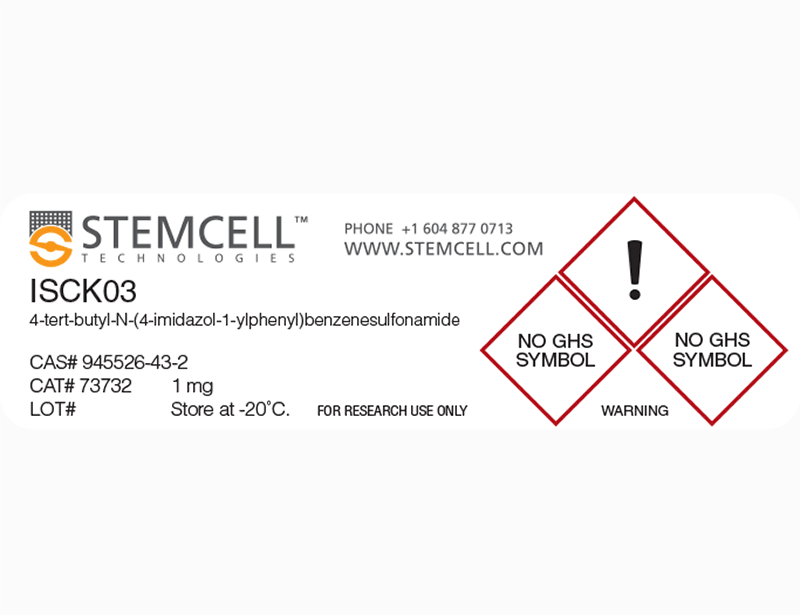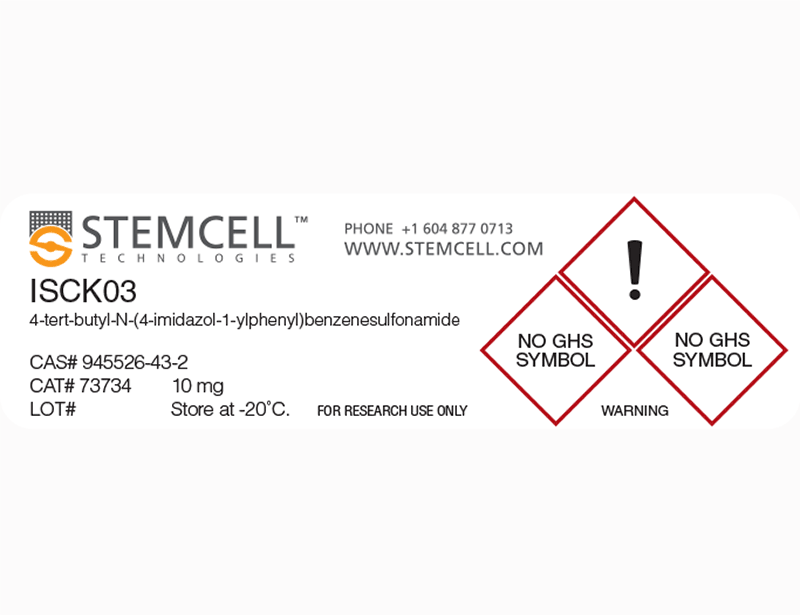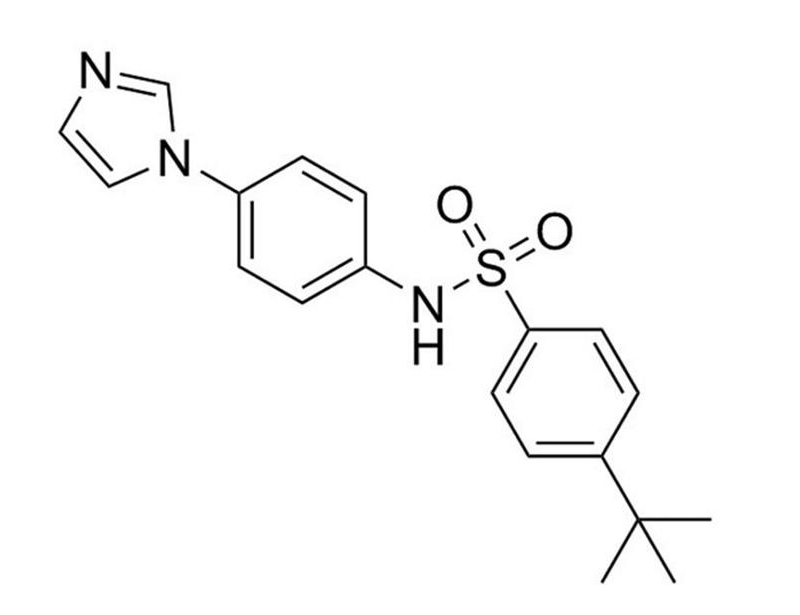概要
ISCK03 (inhibitor of SCF/c-KIT) is a cell-permeable phenyl-imidazolosulfonamide compound that inhibits KIT activity. ISCK03 inhibits SCF-induced c-KIT phosphorylation and downstream ERK phosphorylation at a concentration of 1 - 5 µM in 501mel melanoma cells (Na et al.).
CANCER RESEARCH
· Causes significant decrease in blood vessel density on human lung adenocarcinoma (A549) cells irradiated with X-rays (6 Gy; Kamlah et al.).
· Reduces cell viability and ERK1/2 phosphorylation in acute myeloid leukemia (AML)-derived cell lines (Kon et al.).
CANCER RESEARCH
· Causes significant decrease in blood vessel density on human lung adenocarcinoma (A549) cells irradiated with X-rays (6 Gy; Kamlah et al.).
· Reduces cell viability and ERK1/2 phosphorylation in acute myeloid leukemia (AML)-derived cell lines (Kon et al.).
技术资料
| Document Type | 产品名称 | Catalog # | Lot # | 语言 |
|---|---|---|---|---|
| Product Information Sheet | ISCK03 | 73732, 73734 | All | English |
| Safety Data Sheet | ISCK03 | 73732, 73734 | All | English |
数据及文献
Publications (3)
The Journal of clinical investigation 2013 MAR
Smap1 deficiency perturbs receptor trafficking and predisposes mice to myelodysplasia.
Abstract
Abstract
The formation of clathrin-coated vesicles is essential for intracellular membrane trafficking between subcellular compartments and is triggered by the ARF family of small GTPases. We previously identified SMAP1 as an ARF6 GTPase-activating protein that functions in clathrin-dependent endocytosis. Because abnormalities in clathrin-dependent trafficking are often associated with oncogenesis, we targeted Smap1 in mice to examine its physiological and pathological significance. Smap1-deficent mice exhibited healthy growth, but their erythroblasts showed enhanced transferrin endocytosis. In mast cells cultured in SCF, Smap1 deficiency did not affect the internalization of c-KIT but impaired the sorting of internalized c-KIT from multivesicular bodies to lysosomes, resulting in intracellular accumulation of undegraded c-KIT that was accompanied by enhanced activation of ERK and increased cell growth. Interestingly, approximately 50% of aged Smap1-deficient mice developed anemia associated with morphologically dysplastic cells of erythroid-myeloid lineage, which are hematological abnormalities similar to myelodysplastic syndrome (MDS) in humans. Furthermore, some Smap1-deficient mice developed acute myeloid leukemia (AML) of various subtypes. Collectively, to our knowledge these results provide the first evidence in a mouse model that the deregulation of clathrin-dependent membrane trafficking may be involved in the development of MDS and subsequent AML.
International journal of radiation oncology, biology, physics 2011 AUG
Comparison of the effects of carbon ion and photon irradiation on the angiogenic response in human lung adenocarcinoma cells.
Abstract
Abstract
PURPOSE Radiotherapy resistance is a commonly encountered problem in cancer treatment. In this regard, stabilization of endothelial cells and release of angiogenic factors by cancer cells contribute to this problem. In this study, we used human lung adenocarcinoma (A549) cells to compare the effects of carbon ion and X-ray irradiation on the cells' angiogenic response. METHODS AND MATERIALS A549 cells were irradiated with biologically equivalent doses for cell survival of either carbon ions (linear energy transfer, 170 keV/μm; energy of 9.8 MeV/u on target) or X-rays and injected with basement membrane matrix into BALB/c nu/nu mice to generate a plug, allowing quantification of angiogenesis by blood vessel enumeration. The expression of angiogenic factors (VEGF, PlGF, SDF-1, and SCF) was assessed at the mRNA and secreted protein levels by using real-time reverse transcription-PCR and enzyme-linked immunosorbent assay. Signal transduction mediated by stem cell factor (SCF) was assessed by phosphorylation of its receptor c-Kit. For inhibition of SCF/c-Kit signaling, a specific SCF/c-Kit inhibitor (ISCK03) was used. RESULTS Irradiation of A549 cells with X-rays (6 Gy) but not carbon ions (2 Gy) resulted in a significant increase in blood vessel density (control, 20.71 ± 1.55; X-ray, 36.44 ± 3.44; carbon ion, 16.33 ± 1.03; number per microscopic field). Concordantly, irradiation with X-rays but not with carbon ions increased the expression of SCF and subsequently caused phosphorylation of c-Kit in endothelial cells. ISCK03 treatment of A549 cells irradiated with X-rays (6 Gy) resulted in a significant decrease in blood vessel density (X-ray, 36.44 ± 3.44; X-ray and ISCK03, 4.33 ± 0.71; number of microscopic field). These data indicate that irradiation of A549 cells with X-rays but not with carbon ions promotes angiogenesis. CONCLUSIONS The present study provides evidence that SCF is an X-ray-induced mediator of angiogenesis in A549 cells, a phenomenon that could not be observed with carbon ion irradiation. Thus, in this model system evaluating angiogenesis, carbon ion irradiation may have a therapeutic advantage. This observation should be confirmed in orthotopic lung tumor models.
Biochemical pharmacology 2007 SEP
[4-t-butylphenyl]-N-(4-imidazol-1-yl phenyl)sulfonamide (ISCK03) inhibits SCF/c-kit signaling in 501mel human melanoma cells and abolishes melanin production in mice and brownish guinea pigs.
Abstract
Abstract
It is well known that c-kit is related to pigmentation as well as to the oncology target protein. The objective of this study was to discover a skin-whitening agent that regulates c-kit activity. We have developed a high-throughput screening system using recombinant human c-kit protein. Approximately 10,000 synthetic compounds were screened for their effect on c-kit activity. Phenyl-imidazole sulfonamide derivatives showed inhibitory activity on c-kit phosphorylation in vitro. The effects of one derivative, [4-t-butylphenyl]-N-(4-imidazol-1-yl phenyl)sulfonamide (ISCK03), on stem-cell factor (SCF)/c-kit cellular signaling in 501mel human melanoma cells were examined further. Pretreatment of 501mel cells with ISCK03 inhibited SCF-induced c-kit phosphorylation dose dependently. ISCK03 also inhibited p44/42 ERK mitogen-activated protein kinase (MAPK) phosphorylation, which is known to be involved in SCF/c-kit downstream signaling. However ISCK03 did not inhibit hepatocyte growth factor (HGF)-induced phosphorylation of p44/42 ERK proteins. To determine the in vivo potency of ISCK03, it was orally administered to depilated C57BL/6 mice. Interestingly, oral administration of ISCK03 induced the dose-dependent depigmentation of newly regrown hair, and this was reversed with cessation of ISCK03 treatment. Finally, to investigate whether the inhibitory effect of ISCK03 on SCF/c-kit signaling abolished UV-induced pigmentation, ISCK03 was applied to UV-induced pigmented spots on brownish guinea pig skin. The topical application of ISCK03 promoted the depigmentation of UV-induced hyperpigmented spots. Fontana-Masson staining analysis showed epidermal melanin was diminished in spots treated with ISCK03. These results indicate that phenyl-imidazole sulfonamide derivatives are potent c-kit inhibitors and might be used as skin-whitening agents.

 网站首页
网站首页





